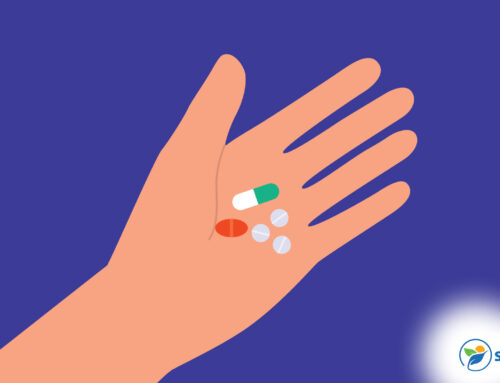Roughly 11% of Americans over the age of 10 suffer from alcohol use disorder. For these individuals, the drug disulfiram can assist with treatment and potentially reduce the risk of relapse. However, there’s a risk of experiencing disulfiram side effects associated with medication-assisted treatment (MAT). Read on to learn more about possible disulfiram interactions and side effects and how they can be managed.
Navigating Disulfiram: Unraveling the Side Effects
Disulfiram is a prescription medication that discourages drinking by causing unpleasant symptoms when a person consumes alcohol after taking the drug. Alcohol-disulfiram interactions can cause:
- Anxiety
- Blurred vision
- Confusion
- Flushing of the face
- Headaches
- Sweating
- Vomiting
The signs of alcohol-disulfiram interactions typically start about 10 minutes after drinking alcohol and last for about an hour before they resolve on their own. As a result, it can be an effective way to encourage a person with alcohol use disorder to abstain from drinking.
In most cases, the disulfiram side effects that occur after drinking aren’t a cause for concern. However, if a person drinks an excessive amount, more severe and potentially life-threatening side effects can develop, including:
- Breathing problems
- Heart problems
- Seizures
Even people who don’t drink may develop unwanted side effects from taking disulfiram. Fortunately, these effects are typically mild.
Unveiling Disulfiram Side Effects: What to Watch for During Treatment
There are other common disulfiram side effects, including:
- Acne
- Drowsiness
- Fatigue
- Impotence in men
- Metallic taste in the mouth
- Mild headaches
- Reduced libido
- Skin rashes
Side effects can develop at any time, but they most commonly occur when a person starts taking the medication for the first time.
Balancing Benefits and Risks: Understanding Disulfiram’s Side Effects
Before starting MAT with disulfiram, it’s important to discuss both the benefits and the risks of the drug with a health care provider. While the medication can cause side effects, the most common ones are manageable, and for many people, the benefits of discouraging alcohol consumption outweigh the possibility of experiencing adverse events.
As a result, a fear of potential side effects shouldn’t prevent a person with alcohol use disorder from seeking treatment.
When exploring options for MAT therapy, a health care provider will consider a person’s health history, as individuals with certain medical conditions may not be able to safely take disulfiram. Generally, the drug shouldn’t be prescribed for women who are pregnant or may become pregnant as well as people with:
- Brain damage
- Diabetes
- Epilepsy
- Kidney disease
- Liver disease
- Thyroid disease
Disulfiram can also increase the risk of bleeding, so people scheduled for surgery typically shouldn’t be given the drug. Along with causing symptoms when used with alcohol, disulfiram can interact negatively with other medications, such as:
- Amitriptyline
- Blood thinners
- Isoniazid
- Metronidazole
- Over-the-counter cold and flu medications that contain alcohol
- Phenytoin
Tackling Disulfiram’s Side Effects: Strategies for Managing Treatment
Developing strategies for managing potential side effects can help a person weather mild adverse reactions and continue with treatment. The following are some tips for managing disulfiram side effects.
Avoid Alcohol
Abstaining from consuming alcoholic beverages is key to preventing disulfiram interactions. In addition, you should avoid foods and other products that contain alcohol, such as:
- Aftershave
- Antiperspirants (certain products)
- Antiseptic astringents
- Cooking wine
- Desserts that contain alcohol
- Hair dyes
- Mouthwash
- Perfume and cologne
- Vinegar
Read labels carefully to identify products that contain alcohol. When dining out, let your server know you can’t eat foods made with vinegar or alcohol so they can advise you on which dishes to order. Keep in mind that alcohol-disulfiram interactions can occur up to 14 days after you stop taking the medication.
Give Yourself Time to Adjust
Mild side effects from medications often subside once your body adjusts to them. Try to start taking disulfiram when you have time off from work so you can rest. You might also avoid driving or operating heavy machinery after taking the medication until you know how it affects you.
Take Your Medication as Prescribed
Taking disulfiram as directed by your health care provider may help reduce the risk of side effects. Avoid skipping doses, and if you do forget, don’t take a double dose to try to catch up.
Wear a Medical Alert Bracelet
Because disulfiram can interact with other prescription medications, consider wearing a medical alert bracelet or carrying a card to alert first responders and health care providers that you’re taking the drug. Doing so can help ensure you aren’t prescribed medication that triggers a reaction, such as metronidazole 500 mg tablets or capsules to treat an infection.
Notify Your Health Care Provider of Mild Side Effects
Stay in touch with your health care provider when you begin taking disulfiram. If you experience mild side effects, they may recommend treatments such as over-the-counter pain relievers for headaches. They can also give you advice on lifestyle changes and self-care interventions that can help you feel better.
Disulfiram and Side Effects: A Closer Look at Potential Health Impacts
Beyond minor side effects, disulfiram does have the potential to cause more severe health impacts, such as liver failure and nerve damage, which medical professionals refer to as neuropathy.
Fortunately, these occurrences are rare. In fact, fatal liver failure occurs in only one in every 3,000 cases treated per year, while neuropathy impacts one in every 1,000 people treated with the drug each year.
Warning signs of severe side effects from disulfiram include:
- Changes in vision
- Dark urine
- Numbness, pain or tingling, especially in your hands or feet
- Pain in the upper right belly
- Yellowing of the skin and eyes
If you experience any of the above symptoms, let your health care provider know immediately.
Safety First: Monitoring and Addressing Side Effects of Disulfiram
When severe health effects from disulfiram occur, they usually develop gradually over time. Health care providers typically order periodic blood work to assess liver function and catch problems early. Be sure to attend all follow-up appointments with your medical provider, and keep them up to date on any new symptoms you experience while taking disulfiram.
Get Help for Alcohol Use Disorder
Taking disulfiram is just one potential treatment for alcohol use disorder. At Sunlight Recovery, our team of medical and mental health professionals develops customized treatment plans that can include medical detox, individual and group therapy and MAT. By taking an individualized approach, we can develop a plan based on your unique needs and help you get started on a better life free of alcohol. Contact us today to learn more about your treatment options.






